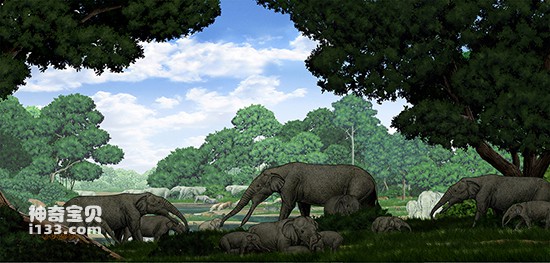Among the elephantoids, the main group of proboscis, the development of a pair of huge upper incisors (ivory) has become a distinctive feature of this group. This structure is often used as a feeding tool for individuals and as a weapon for males to compete for mating rights. Proboscideans without tusks usually only exist in primitive taxa that differentiated before the Oligocene. For example, Deinophorus only developed a pair of hook-shaped lower incisors and the upper incisors were completely missing. In the early stages of the evolution of Elephants-Are-Endangered.html">elephants, a group called the Amebelodontidae appeared. Their mandibles and lower incisors were particularly elongated and widened, forming a shovel-like structure. This peculiar evolutionary direction has been attract the attention of researchers. There have been many hypotheses and studies over the years regarding the significance of the spade-shaped mandible in terms of functional morphology of the family Spadeodontidae.
& nbsp; A cluster of exquisitely preserved phylodontid fossils from the Ergou site was recently published online in the international journal "Journal of Systematic Palaeontology." This fossil cluster is represented by 11 fairly complete individuals of different sexes and ages. They have shovel-shaped lower jaws and lower incisors. They undoubtedly belong to the family Shododontidae. However, their tusks are missing regardless of gender and age. One feature has been discovered for the first time in the Elephant type, which is like a strange combination of Deinodon and Shodon. This new group was named Aphanobelodon zhaoi gen. et sp. nov. The genus name "Cryptodon" refers to its main feature of missing tusks; while the species name is dedicated to Mr. Zhao Rong, the discoverer of the fossil group.
The important significance of the discovery of Cryptodontus is that it reveals the diversified morphology and ecology of Elephants-Are-Endangered.html">elephants in their early evolution. Research and examination of branch systems have proven that Cryptodontus exists as a sister group to Platybelodon in terms of phylogenetic evolution. However, the internal structure of its lower incisors is very different from that of Platybelodon, and is different from that of Platybelodon. Another type of Protanancus is similar. In this way, the similarity in the structure of the lower incisors is no longer a criterion for distinguishing members of the family Protanancus, but a parallel evolution phenomenon under the influence of selection pressure. Research on micromark analysis and mechanical analysis proves that within the family Shovelodonidae, the group represented by Cryptodontidae and Shoveldon are specialized in feeding on young leaves, and their wide, shovel-shaped mandibles are mainly used for cutting. twigs and young leaves; while another group represented by the Protothecodon has a wider range of feeding habits. The narrow shovel-shaped mandible can be used to dig plants shallow under the ground, and ivory also plays a role in food collection. played an important role. Systemic divergence within the family Pleurodontidae also represents an ecological divergence.
Males of Cryptodontus also lacked upper incisors, suggesting that fighting between males may not have been very intense. Therefore, the social structure of cryptodonts is likely to be different from that of other Elephants-Are-Endangered.html">elephants. Perhaps among cryptodonts, males and females formed a stable breeding group and worked together to raise their juvenile offspring. This is very different from the matrilineal society in modern elephants where females form large groups to raise their offspring.
This research was funded by the National Basic Research Program, the Chinese Academy of Sciences, the National Natural Science Foundation, and the Basic Work Special Project of the Ministry of Science and Technology.

Figure 1: Cryptodont individuals of different ages and genders (Photo provided by Wang Shiqi)

Figure 2: Restoration map of the cryptodont’s living environment (painted by Chen Yu)
animal tags: Cryptodontus Proboscidea Evolution Fossil
We created this article in conjunction with AI technology, then made sure it was fact-checked and edited by a Animals Top editor.